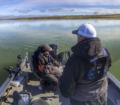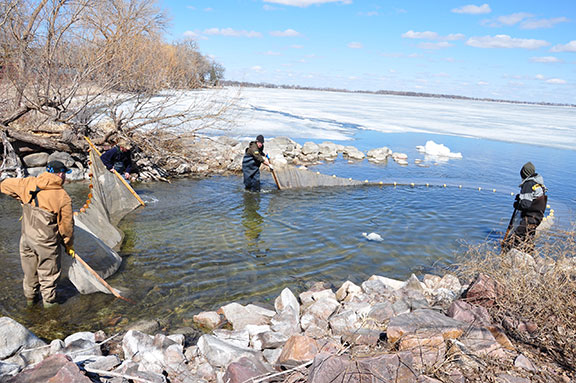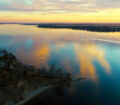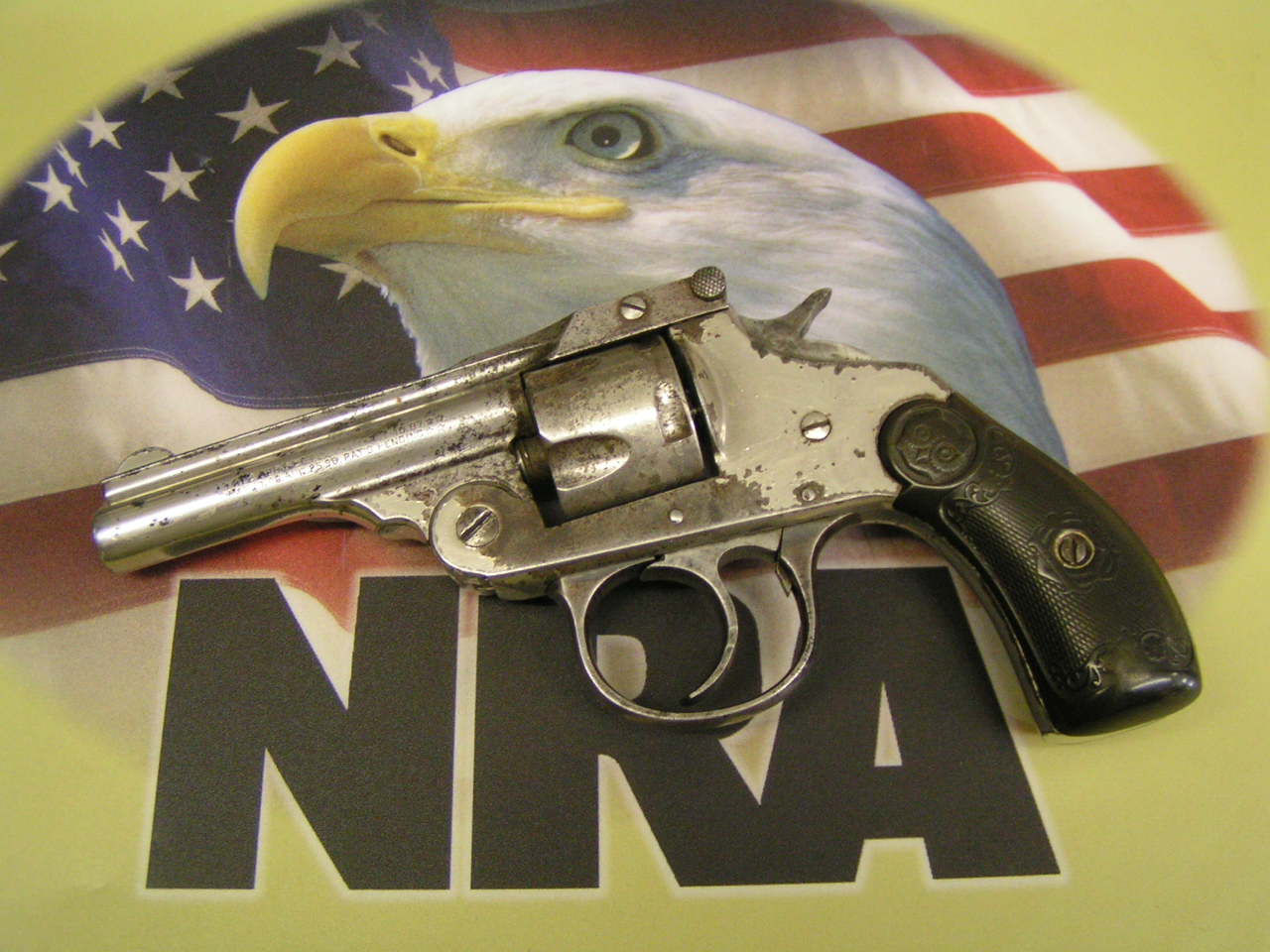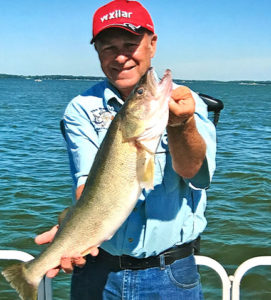
(photo by Mark DeVore) The author with an over the slot walleye taken on Big Spirit Lake in June.
By Steve Weisman
You can feel the excitement as anglers prepare for the Iowa Great Lakes Walleye Weekend. Always held the first full weekend in May (Saturday, May 6 and Sunday, May 7), people travel from near and far to be part of the annual event. Of course, each year the main question revolves around how the opener will go. The bottom line is what kind of weather Mother Nature will deal out. Over the years, we’ve had everything from snow to sleet to wind to calm and temperatures barely into the 30s to temperatures in the 70s. Right now, the long-range forecast is highs in the 60s and lows in the 40s with a chance chance of showers. That, of course, can change.
First, let’s take a look at a pre-fishing opportunity on Friday.
Great Lakes Marine Opener Kick-off
The Friday of Walleye Opener is always one of great anticipation. Anglers looking to talk “fishing and boats” are invited to the Great Lakes Marine Open House on Friday, May 5 from 8 a.m. to 9 p.m.
Following a day of informal fishing talk and the opportunity to look at the new Triton, Warrior and Alumacraft boats and Premier Pontoons powered by Evinrude, Mercury and Yamaha motors, the focus will turn to a series of seminars. Cost for the evening is $10, which will include a meal, the seminars and the opportunity to win a wide array of door prizes.
The meal begins at 5 p.m., followed by three seminars:
- The first speaker will be Alumacraft and Evinrude Pro-staffer Jon Thelen, host of the highly-acclaimed fishing program, Lindy Legendary Fishing Tackle’s Fish Ed TV, which appears on Fox Sports North. A longtime fishing guide, Thelen will share his knowledge of “Early Spring Fishing Techniques,” which is a perfect topic for the Walleye Opener.
- Next Humminbird Pro Staffer Scott Petersen, who will be discussing Humminbird Electronics and how to “Simplify Your Electronics.”
- Then to finish the night Lowrance Pro Staffer Dan McGannon will lead a hands-on demonstration with touchscreen Lowrance electronics. Great Lakes Marine will have units available at the tables for those in attendance to replicate what McGannon will be showing.
Cost of the meal and seminar is $10. Door prizes will be given out throughout the seminars. Call and register today at Great Lakes Marine for the meal and seminars at (712) 336-3822.
Fishing Forecast
The opener is about giving anglers the chance to fish for a wide range of fish from bass to panfish to northern pike to bullheads. However, it is the walleye that garners the most interest. The netting results at the Spirit Lake Hatchery were outstanding. The total number of broodstock brought into the hatchery in one week was 2781 walleyes. In four nights, Big Spirit yielded 1513 fish! In visiting the hatchery multiple times, I was impressed with the quality and health of the broodstock. It is obvious that the forage base is excellent on all lakes. From an angler perspective that is good, but at the same time it might make the catching a little more difficult. The fish can eat when and where they want!
In addition, water clarity can play a huge part in angler success. The clearer the water, the tougher fishing becomes during the daylight hours. A couple years ago, on Big Spirit we could see bottom in over 15 feet of water. Talk about tough! Now, the water clarity becomes less important if there is a wind to cause waves and cut the light penetration. However, a gale can also limit where anglers can fish.
I would guess the best walleye fishing, as it so often seems to be, will occur during the late evening and nighttime hours. After dark, the lakes will light up with boat lights and dock lights on. Water movement is also a key, and water is coming into the system. Of course, this kicks off what we all hope will be a great year of open water fishing on the Iowa Great Lakes.
Collecting data
This past week I visited with DNR Fisheries Biologist Mike Hawkins to learn more about our Big Spirit and Okoboji walleye populations. Hawkins said, “Data collected during last fall’s surveys and this spring’s gillnetting operation give us a good picture of the fishery.” The fall survey consists of night time, boat electrofishing, which is completed to check the status of the young walleyes from the young of the year (5+ inches) to 15-inch fish. Since the smaller walleyes are in the shallows, they are more easily accessible. A generator and control box on the boat creates a specific electrical current in the water that temporarily stuns the fish, so that fisheries workers can get collect them in long handled nets and lift them to an onboard livewell. Information on size, body condition, numbers, and catch rate can be recorded.
In the spring, fisheries biologists get another look at the population during gill netting process. This usually takes place in early to mid-April with the broodstock walleyes collected and brought in to the hatchery to collect the eggs and sperm. Since the gillnets usually only catch walleyes greater than about 17 inches, biologist use this opportunity to assess the larger fish in the lake. While they have them in hand, each walleye is counted, measured and tagged with a special RF ID chip.
Hawkins addressed a concern of anglers the past couple of years: the small number of keeper fish in that 14-17 inch size. There were lots of slot fish (17-22 inch) caught, but they, of course, must be immediately released. However, last fall’s electro fishing showed excellent numbers of a year class length between 12.5 inches and 15 inches on Big Spirit. They should have added another inch in length by this spring. The Okobojis, meanwhile, though not as dense, showed a good population of 12 inch to 15.5 inch fish. These should now be in the 13 to 16.5 inch range this spring. So, the chances of catching keepable walleyes in 2017 is excellent. At the same time, a good year class of 5 to 8 inch fish appears to be on the way. Hawkins noted that electrofishing next fall will give a better indication if they have survived beyond this level.
This is the general information of this year’s gill netting data by lake. Remember, the gillnets used during the spring really only capture the larger fish in the population
Big Spirit
A total of 1046 males were brought into the hatchery with the smallest male collected at 11.5 inches, the average length was 20.2 inches with the largest male 23.5 inches. A total of 784 females were netted with the smallest measuring 15.6 inches, the average length being 22.7 inches and the largest at 27.7 inches.
East Okoboji
A total of 273 males came from East Okoboji with the smallest male collected at 14.1 inches. The average male length was 20.4 inches with the largest male measuring 23.7 inches. A total of 373 females were netted with the smallest measuring 14.8 inches, the average length being 22.5 inches and the largest at 29.1 inches.
West Okoboji
A total of 276 males came from West Okoboji with the smallest male collected at 14.2 inches. The average male length was 21.1 inches with the largest male measuring 25.5 inches. A total of 131 females were netted with the smallest measuring 17.2 inches, while the average female length was 23.9 inches and the largest at 29.0 inches.
Broodstock abundance
Through all the research done on walleyes during the broodstock population, biologists are able to estimate the number of fish in the lakes, their survival or mortality rates, and growth characteristics. Broodstock numbers vary by the year based on many variables. Since 1991, the largest number of broodstock walleyes in Big Spirit occurred in 2008 with an estimated 14,000 walleyes over 17 inches. According to Hawkins, this number was actually too high for a healthy walleye fishery and growth was negatively affected. For the last four years, the numbers have come down to more healthy numbers and ranged between 8,000 and 12,000 broodstock. On the Okobojis, the numbers have never been as high as Big Spirit, but they still show a consistency above the 3,500 broodstock average. The highest broodstock estimated number was 8,000 walleyes in 2014. The last two years remain above the average at 6,000 in 2015 and 4,500 in 2016. Hawkins adds, “Not only do these good numbers mean an excellent chance to catch a trophy, but they also indicate there are plenty of fish available for capture in the spring for egg and fry production.”
Future Management
Hawkins reports that although walleye fishing for walleyes under the slot should show some pretty dramatic improvements this year, consistent survival of stocked walleyes remains a goal. Ongoing research into the survival of these fish continues to add knowledge and tools to the operation. Overall, a number of walleye fisheries in the area are showing better consistency and Hawkins says their goal is to continue to improve their management techniques to reduce the time between good fishing years. Finding out how to consistently get good survival of combinations of walleye fry and fingerlings is and has been the “Holy Grail” of walleye management.


